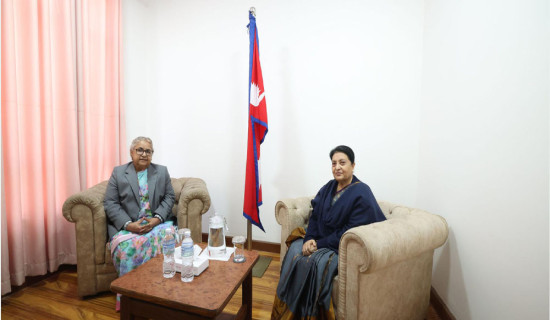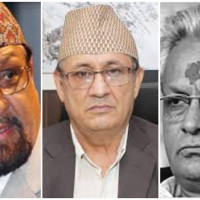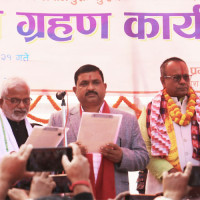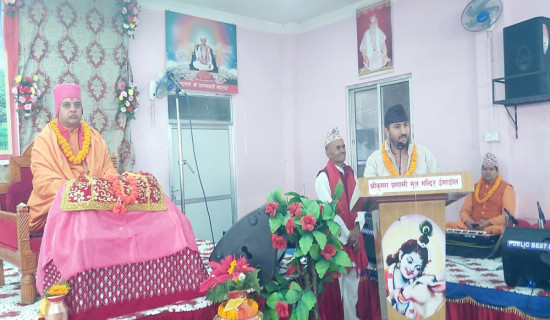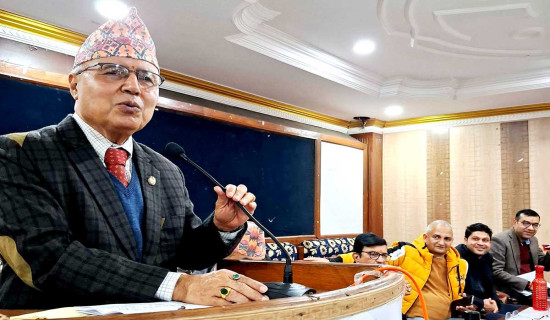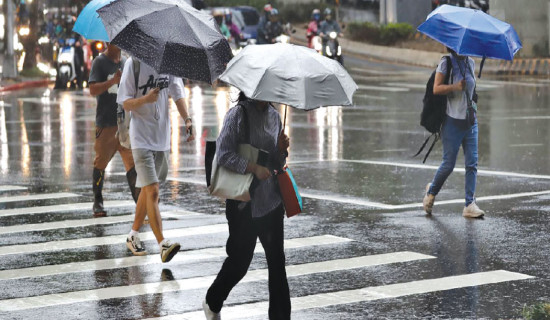- Monday, 8 December 2025
From ample snow to scarcity: Silent crisis in the Himalayas
Kathmandu, May 11: David Gyabu Sherpa, a mountaineer and rescue climber, saw a lot of glacier ice around the Sagarmatha (Mt. Everest) base camp in 2010, when he started climbing mountains. Glaciers surrounded the base camp area back then, but now there is water all around. “The glacier level has retreated from where it used to be,” he said.
When Sherpa summited Sagarmatha last year, he noticed that the glaciers had shifted upward from where they used to be. Expressing his concern, he said, “Billions of people have their life and livelihood connected to these glaciers and their water. If the glaciers keep melting at this rate, people will face water shortages in the coming years.”
Snowfall traditionally occurred in December, January and February, during the winter months when snow could accumulate and contribute to glacier formation. But in recent years, he has noticed snowfall happening in March, when temperatures are already rising, causing the snow to melt quickly instead of forming the glaciers.
Sherpa, who has summited the highest peaks on all seven continents and, until 2024, was the youngest person to climb all 14 eight-thousanders, also holds the Guinness World Record for the ‘Fastest time to climb Sagarmatha and K2,’ a feat he achieved within 61 days. He said he has seen glaciers retreating at every mountain he has summited.
Recently, ICIMOD published the latest Snow Report 2025, which said the Hindu Kush Himalaya (HKH) region experienced its third consecutive below-normal snow year in 2025, with snow persistence (the fraction of time snow is on the ground after snowfall) hitting a vicennial record (records in 20 years) low of -23.6 per cent.
This is worrying news for the water security for nearly two billion people across 12 major river basins that originate high in the HKH, scientists said.
During the release of the report, Pema Gyamtsho, Director General at the International Centre for Integrated Mountain Development (ICIMOD), said carbon emissions have already locked in an irreversible course of recurrent snow anomalies in the HKH.
“To tackle this regional snow crisis and the challenges it creates for long-term food, water and energy resilience, we urgently need to embrace a paradigm shift toward science-based, forward-looking policies and foster renewed regional cooperation for transboundary water management and emissions mitigation.”
To address the alarming situation, the World Meteorological Organisation (WMO) and UNESCO have launched a global campaign, the “International Year of Glaciers Preservation,” aimed at raising awareness and promoting action on the impacts of melting glaciers. The campaign was officially launched on March 21.
Alarming situation
Nepal lacks up-to-date data on the current status of its glaciers, according to Dr. Rijan Bhakta Kayastha, Professor of Glaciology at the Himalayan Cryosphere, Climate and Disaster Research Centre (HiCCDRC), Kathmandu University.
Citing past studies, Dr. Kayastha said Nepal had 3,252 glaciers in 2001, which increased to 3,808 by 2010. The number of glacial lakes also fluctuated: 2,323 in 2001, dropping to 1,466 in 2010, and rising again to 2,070 by 2015. He explained that these changing figures are the result of glacier melting, thawing, division and merging processes.
Dr. Kayastha, referring the ICIMOD’s data, also warned about 47 potentially dangerous glacial lakes located in Nepal’s major river basins, 42 in the Koshi, three in the Gandaki and two in the Karnali.
From 1977 to 2010, Nepal lost 24 per cent of its glacier area and 29 per cent of its ice reserves. This significant loss poses serious concerns for the country’s water resources and the livelihoods that depend on them, he said.
Sharad Prasad Joshi, Glacier Analyst at ICIMOD, said glaciers are shrinking across the country, but the Yala Glacier in Langtang, located at an altitude of 5,090 metres, is melting the fastest.
Joshi, who has been involved in glacier monitoring for the past 13 years, has closely observed the retreat of the Yala Glacier. “In the past 13 years alone, Yala Glacier has narrowed by 50 per cent,” he said.
Joshi is currently on an expedition to the Yala Glacier in Nepal's Langtang Valley, accompanied by scientists from five countries, glaciology students from Kathmandu University and academic researchers. The visit is part of a glacier tribute campaign aimed at raising global awareness about climate change and glacier loss.
As part of the initiative, a giant memorial plaque carved from Nepali granite will be installed at the Yala Glacier base camp on Tuesday, May 13. The plaque serves as a message to future generations, commemorating the rapid retreat of Yala Glacier, one of the longest-studied and most consistently monitored glaciers in the HKH region.
Comparing current data with the first official measurement conducted in 1974, Joshi said the glacier area has shrunk by 66 per cent overall in Yala. More recently, data from February 2025 showed that the Yala glacier has lost 50 per cent within a 13-year period. “The Yala glacier retreated more rapidly during the 2000s than it did in the 1970s,” he added, stressing the accelerating impact of climate change on the country’s high-altitude glaciers.
“If this trend of melting continues, Yala Glacier will only remain as rock. So, we classify it as a glacier in risk due to climate change,” he said. Yala is just a representative, but there are many other glaciers that are shrinking due to climate change, Joshi said.
Talking about the Yala tribute, Joshi said, the tribute aligns with global efforts to mark the United Nations’ International Year for Glaciers Preservation 2025, highlighting the urgent need for climate action.
The memorial takes place on the eve of the government’s Sagarmatha Sambaad event where glacier loss and the impacts of that loss for water, food, and energy security, will be a central theme.
Melting glaciers threaten water security
Dr. Sher Muhammad, Remote Sensing Specialist (Cryosphere Monitoring Lead) at ICIMOD, said multiple measurements through field-based monitoring and satellite-based mass balance show that the country’s glaciers are unequivocally shrinking and are melting faster than in previous decades.
The trend underscores the urgency of both global mitigation (to slow the warming driver) and local adaptation (lake-hazard management, soot-emission controls, high-mountain protected areas) to safeguard downstream water security and lives, he said.
Nepal’s glaciers are shrinking faster and faster, with their area decreasing by over 20 per cent in the past 30 years and mass-loss rates rising by 65 per cent or more since the late 20th century, he said. Dr. Muhammad said that satellite data and digital elevation models show that glaciers in the Langtang Valley lost ice mass at a rate of –0.45 metres water equivalent per year between 2006 and 2015.
In the Everest region, long-term data reveals a clear acceleration in glacier melting. During the 1960s, glaciers were losing mass at a rate of –0.23 m w.e. per year. This rate increased to –0.38 m w.e. per year between 2009 and 2018, representing an increase of about 65 per cent over the decades. Field-based glaciological mass balance studies conducted by ICIMOD through its annual on-site glacier monitoring have observed consistent glacier thinning, further validating the satellite-based findings.
“As the ice thinned and tongues retreated, the number of glacial lakes increased. At least 54 glacial lake outburst floods (GLOFs) have already been recorded in Nepal,” he said.
How are glaciers measured?
Joshi said that while various glacier measurement techniques are used globally, in Nepal, field-based glaciological mass balance study has remained one of the most reliable methods. The use of nigalo (Himalayan bamboo) sticks remains one of the most environmentally friendly approaches, he added.
He explained that a team of scientists visits the glacier site and inserts nigalo sticks into the ice, typically covering a depth of three to four metres. The following year, they return to observe changes in the glacier’s volume by measuring how much of the stick remains exposed, providing a clear indication of melting or accumulation.
Dr. Kayastha said glacier measurement in Nepal is a crucial scientific endeavour, given the country's dependence on glaciers for freshwater and the rising concerns about climate change.
According to scientists, various methods are used to monitor glacier changes, including remote sensing and satellite data (using satellite images to track glacier size, volume, and movement over time), ground-based surveys (installing stakes and GPS devices to measure ice loss and accumulation), aerial and drone surveys (capturing high-resolution images of glacier surfaces), and automatic weather stations (AWS) to monitor temperature, precipitation, and melt rates at high altitudes.
Preserving glaciers: A global and local challenge
With the WMO and UNESCO declaring 2025 as the Year of Glacier Preservation, scientists have stressed that while it is not possible to stop or freeze glaciers, their retreat can be slowed, but only with strong global commitment.
“It is not possible to preserve or freeze glaciers,” said Dr. Muhammad. “But we can slow their retreat by cutting greenhouse gas and soot emissions and by managing water, land and natural hazards more wisely. This way, we help protect the critical services glaciers provide.”
Dr. Muhammad added that urgent global climate action, combined with smart local adaptation, is key. “The faster we align international climate action with local solutions, the more ice we save, and with it, the water security and livelihoods of millions downstream,” he said.
Dr. Kayastha stressed that the retreat of glaciers in the country is an alarming indicator of the growing impacts of climate change.
“There must be strong global efforts to address this issue by implementing climate policies effectively,” he said. “International platforms like the UN climate conferences (COPs) should give serious attention to glacier retreat, work to minimize carbon emissions and ensure the effective implementation of the Paris Agreement of limiting global warming to 1.5 degrees Celsius.”



